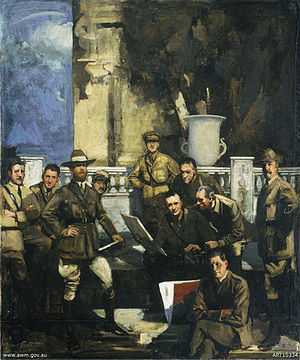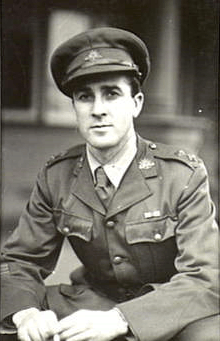Australian official war artists

Australian official war artists are those who have been expressly employed by either the Australian War Memorial (AWM) or the Army Military History Section (or its antecedents).[1] These artist soldiers depicted some aspect of war through art; this might be a pictorial record or it might commemorate how war shapes lives.[2]
War artists have explored a visual and sensory dimension of war which is often absent in written histories or other accounts of warfare.[1] Official war artists have been appointed by governments for information or propaganda purposes and to record events on the battlefield;[3] but there are many other types of war artist.
A war artist creates a visual account of war by showing its impact as men and women are shown waiting, preparing, fighting, suffering, celebrating,[4] The works produced by war artists illustrate and record many aspects of war, and the individual's experience of war, whether allied or enemy, service or civilian, military or political, social or cultural. The rôle of the artist and his work embraces the causes, course and consequences of conflict and it has an essentially educational purpose.[2] For example, C.E.W. Bean's Anzac Book influenced the artists who grew up between the two world wars; and the war art of their childhoods provided a precedent and format for them to follow as war artists of the Second World War.[5]
The AWM have appointed war artists to record the activities of Australian forces in Korea, Vietnam, East Timor and Afghanistan; and both the AWM and the Australian Army have appointed official war artists to depict Australian forces in Iraq.
First World War
.jpg)
The Australian tradition of war artists started with the First World War.
Will Dyson, an expatriate Australian artist living in London petitioned the Australian government to allow him to travel to the Western Front where Australian forces were fighting. In 1917 he was finally granted permission to accompany the Australian Imperial Force to record the activities of its soldiers and thus became the first Australian official war artist.
This early scheme was expanded upon and other Australian artists were commissioned to undertake forays to the front lines to record the Australian experience of war. Artists who had already enlisted and were fighting with the AIF, were appointed official war artists for the Australian Army.
Second World War
During the Second World War, the Australian War Memorial, continued the scheme and appointed war artists whilst the Australian Army, Royal Australian Navy and Royal Australian Air Force appointed their own official war artists from within their ranks. Other venues have honored Australian participation in the war.[6]
Selected artists
- This is an incomplete list that may never be able to satisfy particular standards for completeness. You can help by expanding it with reliably sourced entries.
First World War
- George Bell, 1878–1966.[7]
- George Courtney Benson, 1886–1960.[7]
- Frederick C. Britton, 1889–1931
- Charles Bryant, 1883–1937.[7]
- George Coates[8]
- Frank R. Crozier, 1883–1948.[7]
- Will Dyson, 1880–1938.[7]
- A. Henry Fullwood, 1863–1930.[7]
- Charles Web Gilbert, 1867-1925.[8][9]
- John C. Goodchild 1898–1980
- George Washington Lambert, 1873–1930.[7]

- Fred Leist, 1878–1945.[7]
- Daryl Lindsay[8][10]
- John Longstaff, 1862–1941.[7]
- Will Longstaff, 1879–1953.[7]
- Louis Frederick McCubbin, 1890-1952.[7][11]
- W. B. McInnes[8]
- H. Septimus Power, 1877–1951.[7]
- James Quinn, 1869–1951.[7]
- James F. Scott 1877–1932.[7]
- Arthur Streeton, 1867–1943.[7]
- Charles Wheeler[8]
Second World War

- Harold Abbott, 1906–1986.[12]
- Dennis Adams, 1914–2001.[12]
- Richard Ashton, 1913–2001.[12]
- George Allen, 1900–1972.[12]
- Yosl Bergner, 1920– .[13]
- Stella Bowen, 1893–1947.[12]
- Ernest Buckmaster, 1897–1968.[12]
- Colin Colahan, 1897-1987.[12][14]
- William Dargie, 1912–2003.[12]
- William Dobell, 1899–1970.[15]
- Russell Drysdale, 1912–1981.[16]
- Ray Ewers, 1917–1998.[12]
- Harold Freedman, 1915–1999.[17]
- Donald Friend, 1915–1989.[12]
- John C. Goodchild, 1898–1980.[12]
- Murray Griffin, 1903–1992.[12]
- Henry Hanke, 1901–1989.[12]
- Ivor Hele, 1912–1993.[12]
- Sali Herman, 1898–1993.[12]
- Nora Heysen, 1911–2003.[12]
- Frank Hinder, 1906–1992.[18]
- Ludwig Hirschfeld Mack, 1895–1965.[19]
- Frank Hodgkinson AM, 1919-2001.[12]
- Herbert McClintock, 1906–1985.[12]
- Arthur Murch, 1902–1989.[12]
- Sidney Nolan, 1917–1992.[20]
- Frank Norton, 1916–1983.[12]
- Tony Rafty, 1915– .[12]
- Grace Cossington Smith, 1892–1984.[8][21]
- Grace Taylor, 1897–1988.[22]
- Ralph Walker, 1912–2003.[12]
Recent conflicts
- Rick Amor, 1948– , Peacekeeping in East Timor.[23]
- Jon Cattapan, 1956– , Peacekeeping in East Timor.[23]
- Peter Churcher, 1964– , War on Terrorism.[23]
- George Gittoes AM, 1949– .[8][24]
- Shaun Gladwell, 1972– , War in Afghanistan.[23]
- Bruce Fletcher, 1937– , Vietnam War[23]
- Ivor Hele, 1912–1993, Korean War[23]
- eX de Medici, 1959– , Regional Assistance Mission to Solomon Islands[23]
- Ken McFadyen, 1939–1997, Vietnam War[23]
- Lewis Miller, 1959– , War in Iraq.[23]
- Frank Norton, 1916–1983, Korean War[23]
- Wendy Sharpe, 1960– , Peacekeeping in East Timor[23]
See also
- War artists
- Military art
- War photography
Notes
- ↑ 1.0 1.1 Australian War Memorial (AWM): Australian official war artists
- ↑ 2.0 2.1 Imperial War Museum (IWM), About the Imperial War Museum
- ↑ National Archives (UK), "'The Art of War,' Learn About the Art."
- ↑ Canadian War Museum (CWM), "Australia, Britain and Canada in the Second World War," 2005.
- ↑ Reid, John B. (1977). Australian Artists at War, Vol. 2, p. 5.
- ↑ CWM, "Interpreting the war: Australia's Second World War art" by Lola Wilkins, 2005.
- ↑ 7.0 7.1 7.2 7.3 7.4 7.5 7.6 7.7 7.8 7.9 7.10 7.11 7.12 7.13 7.14 AWM, First World War, official artists
- ↑ 8.0 8.1 8.2 8.3 8.4 8.5 8.6 National Gallery of Australia (NGA). "War Artists" by Anna Gray; excerpt, artists "were commissioned to paint portraits and large battle pictures after the war."
- ↑ Reid, John B. (1977). Australian Artists at War, Vol. 1, pp. 13-14.
- ↑ NGA, "War Artists"; excerpt, "Daryl Lindsay was seconded to become a medical artist at the Queen Mary Hospital at Sidcup, Kent, in England."
- ↑ Gray, Anne. (1986). "McCubbin, Louis Frederick (1890 - 1952)," Australian Dictionary of Biography, Vol. 10, pp. 243-244; Reid, p. 15.
- ↑ 12.0 12.1 12.2 12.3 12.4 12.5 12.6 12.7 12.8 12.9 12.10 12.11 12.12 12.13 12.14 12.15 12.16 12.17 12.18 12.19 12.20 12.21 AWM: Second World War, official artists
- ↑ CWM, Yosl Bergner
- ↑ Colahan, Colin - Australian War Memorial; An article and images of Colahan's war art compiled by Garry Kinnane., Journal of the Australian War Memorial, retrieved 2011-08-31
- ↑ CWM, William Dobell
- ↑ CWM, Russell Drysdale
- ↑ CWM, Harold Freedman
- ↑ CWM, Frank Hinder
- ↑ CWM, Ludwig Herschfeld Mack
- ↑ CWM, Sidney Nolan
- ↑ CWM, Grace Cossington Smith
- ↑ CWM, Grace Taylor
- ↑ 23.0 23.1 23.2 23.3 23.4 23.5 23.6 23.7 23.8 23.9 23.10 AWM: Conflicts 1945 to today, official artists
- ↑ Order of Australia, George Gittoes, 1997.
References
- McCloskey, Barbara. (2005). Artists of World War II. Westport: Greenwood Press. 10-ISBN 0-313-32153-1/13-ISBN 978-0-313-32153-5; OCLC 475496457
- Reid, John B. (1977). Australian Artists at War: Compiled from the Australian War Memorial Collection. Volume 1. 1885-1925; Vol. 2 1940-1970. South Melbourne, Victoria: Sun Books. 10-ISBN 0-7251-0254-3/13-ISBN 978-0-7251-0254-8; OCLC 4035199
Further reading
- Gallatin, Albert Eugene. Art and the Great War. (New York: E.P. Dutton, 1919).